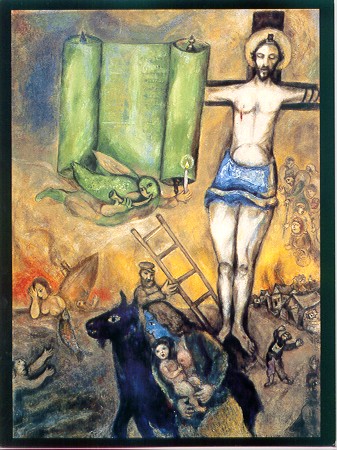Marc Chagall's Yellow Crucifixion
A History 323 Project (Fall 2001)
In fall semester 2001, two students in my History 323 course
on the Holocaust did an art project that involved making a stained-glass version
of the famous artist Marc Chagall's controversial painting, "The Yellow
Crucifixion" (1943). This was one of several paintings Chagall did during
this period in which he attempted to express the horror of the Holocaust by
using the image of the crucified Christ in combination with overtly Jewish
symbols. In this way, he linked Jesus to the fate of the Jewish victims of
Hitler and used the most powerful image of suffering in the Christian iconographic
tradition to confront viewers with the cruelties being inflicted on Jesus's
people.

In "The Yellow Crucifixion," Jesus wears the phylacteries or tefillin
donned by Orthdox Jews for their morning prayers. The off-center figure of
the crucified Jesus shares the central space of the picture with a large depiction
of a Torah scroll. In the lower part of the picture, burning buildings and
figures in postures of agony represent the Jewish victims of the Holocaust
in Chagall's native eastern Europe.
Chagall's crucifixion paintings probably inspired the plot of Chaim Potok's
popular novel, My Name is Asher Lev (1972), in which the principal
character is a young Jewish artist grappling with the fact that the western
artistic tradition is so heavily influenced by Christian imagery and that
the crucifixion image is a uniquely powerful way of expressing human suffering.
For discussions of Chagall's crucifixion paintings, see the articles by Jacob
Baal-Teshuva and Benjamin Harshav in Jacob Baal-Teshuva, ed., Chagall:
A Retrospective (1995)